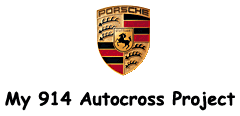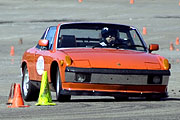
Optimization of Aerodynamic Aids on my 914 for Autocross


|
When I bought my 914 it came with an aftermarket front spoiler. I kept it on the car because I liked the way it looked. It gave the car that kind of racecar look and feel. I bought the car for one use only. To have fun driving it in PCASDR Autocross events! I like working on my cars and driving them. When the car is not at a PCASDR Autocross, it is at home in the garage being worked on. So on the down side the front spoiler adds two points to my class standing for "Non-stock Aerodynamic Aids." For me the look of the spoiler outweighed the added points. Until I have a chance to improve the engine and suspension more, and I need the points for those improvements, I will continue to use the front spoiler. I work at UCSD in the Mechanical and Aerospace Engineering (MAE) Department. Besides classroom lectures for the students we have laboratories were the students go for hands on learning. We have different laboratories for different engineering disciplines. I manage a laboratory where the students learn about Engineering Design. We have a laboratory course class that the students learn about fluid mechanics, solid mechanics, vibration, control systems, and heat exchange and pollution experiments. Each year they ask for projects for the students in these areas. I offered to sponsor and advise a project that would look at the aerodynamic effects of my front spoiler on my 914 and some other rear spoilers that I had bought on Ebay. I wanted to know how the spoilers would affect the performance of my car for Autocross driving. Over the past three years I have sponsored my 914 aerodynamics project three times with three different student groups. Each year the project had different emphases. A lot of what the students do in these types of projects is to apply what they learned in the classroom while at the same time trying accomplishing the goal of the sponsor. Several methods were used to measure the same effects of aerodynamic drag and air flow on my 914. This way the students could verify their results and at the same time learn different scientific and engineering techniques. For all
uses, other then your own private use, The 1st Yearís Group worked on preparing two "Revell" scale models for wind tunnel testing, creating a computer model for airflow and drag coefficient analysis, and purchasing a car data acquisition system. The goal was to take three different approaches to measure the 914's drag coefficient and to compare the results to each other. The studentís first step was to do a literature search on the web and post requests for information on the various 914 forums. It was interesting to find that out that there was all most no aerodynamic analysis of the 914 in the Porsche community. There are a number of people that have added spoilers and wings to their 914's but no aerodynamic testing or analysis has been done using them. A Stratasys Systems 3D Prototyper created the spoilers for the Revell models. 3D computer models were made of the spoilers and then scaled down to match the scale of the Revell models. Because our Stratasys Prototyper can only make parts using wax, female molds were made, and then resin was cast into them to form the spoilers. For the computer analysis, FloWorks was used to model the airflow around the 914 and calculate the drag coefficient. At the time there were no computer models of the 914 and they had to me be made from scratch. All of the spoilers were mounted on the actual 914 to see how they affected the car's drag. The drag measurements were done using a G-Tech Meter. The G-Tech Meter calculates a cars horsepower based on its weight and acceleration.. Because the spoilers affect the aerodynamics of the car it shows up as more or less horsepower. More or less horsepower can be calculated into more or less drag. Their main conclusion was that the front spoiler that came on my 914 increases its drag and should be removed for Autocross driving.
The 2nd Yearís Group worked on testing the models in a water tunnel, performing a traditional yarn test, creating a dye flow visualization, and improving the models and methods used in the computer modeling. Their main conclusions were that computer models could be used to model real world results. It was really interesting to see how the yarn test and the dye visualization really matched up with the computer analysis of the airflow around the 914. Group Project 2006:
The 3rd Years Group was given the chance to be creative. The previous groups measured the aerodynamics effects of drag on the 914 in different ways and then verified the theoretical with the actual real world. This yearís group used everything that was previously learned to Design different aerodynamic improvements for the 914. They looked at the aerodynamic designs that other people were using on their 914's and then came up with several Designs of their own. Because there was so little information in the 914 communities, in regards to the overall aerodynamic characteristic of the 914, the students concentrated there efforts on measuring the drag coefficients and the airflow around the 914. Their Student Presentation Poster shows what they found. The chart also shows downward forces generated. Their main conclusions showed that the stock car is pretty good in regards to drag. Not bad for a 37 year old design. Group Project
2007:
Iím going to have next years group look at the downward effects of the aerodynamics of the 914 and how it performs on larger tracks. Is there anyone out there that would be willing to have the students come take measurements of their large rear wings in SoCal? They will computer model what is currently being used and then try to design improvements that would make them more efficient. They will look at how much downward force the 914 needs to keep it stable at higher speeds in a straight and how much force the 914 needs to keep it stuck to the ground when cornering. Working
with the students has been very rewarding and motivating and their energy is
extremely contagious. Currently my old, tied, 80 hp, 1.7L, with low
compression in one cylinder, is starting to make a crankshaft knocking noise
and needs to be replaced. I've replaced, rebuilt, or upgraded everything in
my car so the motor will be next. After that I will be looking into lightening my
car and possibly using a very large rear wing that other types of cars use
for lower speed racing. The three objectives. The first two looked at rear wings for track and autocross use. The third looked at the flow through the engine compartment.
Group Project 2008:
Group Project 2010:
|